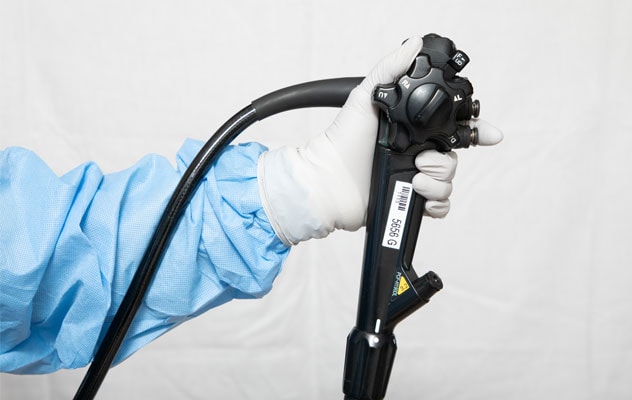Aug. 19, 2022
Research has revealed increasing rates of musculoskeletal symptoms and injury among endoscopists. Repetitive microtrauma and large procedural volumes — particularly among clinicians performing colonoscopy — appear to be associated with a variety of injuries. Injuries to the wrist, hands and fingers appear to be more common and among the most severe.
"Musculoskeletal injuries can negatively affect the ability of practice to keep up with demand," explains gastroenterologist Stephanie L. Hansel, M.D., M.S., from Mayo Clinic in Rochester, Minnesota. "Increasing procedure volumes and longer procedures can play a role in injury."
To further explore the prevalence and impact of procedure-related injuries among endoscopists, Dr. Hansel and co-investigators from the University of California, Davis and Mayo Clinic's campus in Rochester, Minnesota, conducted a study with several unique features. "Our goal was to analyze musculoskeletal injury prevalence, type and distribution," explains Dr. Hansel. "To accomplish this, we gathered self-reported musculoskeletal injury patterns using a validated questionnaire sent to a large cohort of endoscopists, and we compared this self-reported data with provider-specific procedural data, both anthropometric and objective." The results of this study were published in Applied Ergonomics in 2022.
Study methods
The researchers emailed a modified Disabilities of the Arm, Shoulder and Hand (QuickDASH) questionnaire to 179 active endoscopists and trainees with at least one year of experience. This validated, 11-item Likert-scale survey assesses site-specific upper extremity injuries.
The 64 survey respondents who met inclusion criteria reported their age, gender, years practicing endoscopy, height, handedness, any bed height adjustments made before endoscopy, use of specialized footwear at work, and preferred nitrile glove size used during endoscopy (as a proxy for hand size). Survey respondents also reported any foot injury or plantar fasciitis, any function-limiting back or upper extremity pain, and whether any injuries required them to limit or stop endoscopy.
An independent quality analyst from an endoscopy database also extracted each respondent's endoscopic procedure history from the seven years immediately preceding completion of the symptom survey (from 2011 to 2018). Additional provider-specific information gathered from this database included absolute procedure hours and types, colonoscope choice, insertion and withdrawal times, and polyp detection rates.
Key findings
Overall, the study results suggest that musculoskeletal injuries have a measurable impact on procedural volumes, insertion times, scope preferences and possibly polyp detection rates. Baseline demographics, anthropometrics and overall procedural volumes did not differ significantly between respondents who reported function-limiting injuries and those who did not.
Injury locations

Injury locations
Among the 54 survey respondents who reported pain, 50% had pain involving the hand, wrist or finger; 37.5% had back pain; 29.7% had shoulder pain; 26.6% had foot pain or plantar fasciitis; and 18.8% had elbow or forearm pain.
- Injury prevalence: Among the 64 surveys completed, 54 respondents (84.4%) had active pain and 34 (53.1%) reported injury or injuries affecting their daily function.
- Injury locations: Among the 54 respondents who reported pain, 50% had pain involving the hand, wrist or finger; 37.5% had back pain; 29.7% had shoulder pain; 26.6% had foot pain or plantar fasciitis; and 18.8% had elbow or forearm pain.
- Gender-specific injury data: Female respondents reported more foot injuries than male respondents (44.4% versus 19.6%, P = 0.04), and more severe shoulder and elbow injuries. Small hand size (based on glove size) correlated with longer colon insertion times and with a higher prevalence of any function-limiting injury.
Impact of pain or injuries: Respondents who indicated a need to stop or limit endoscopy due to injuries had longer colonoscopy times (25.3 versus 22.1 minutes, P = 0.03) and lower procedural volumes (532.1 versus 806.5, P = 0.01) than peers.
Hand and wrist injuries were associated with longer colonoscopy insertion times (9.3 versus 8.2 minutes, P = 0.01) and a decrease in the number of colonoscopies performed per year (286.3 versus 413.5, P = 0.04). Higher yearly procedural volumes or scope hours were not associated with injury prevalence or severity overall. However, shoulder injuries correlated with lower annual volume of esophagogastroduodenoscopy (EGD) performed (336.5 versus 243.1, P = 0.04).
"Overall, our research reveals increasing rates of musculoskeletal symptoms and injury among endoscopists," explains Dr. Hansel. "More than 50% of the endoscopists who participated in this survey reported that they had activity-limiting musculoskeletal symptoms or injuries. And these symptoms and injuries have a negative impact on procedural volume and efficiency."
Dr. Hansel notes that continued research into the prevalence, type(s) and pathophysiology of injury could help identify ways to mitigate endoscopy-related musculoskeletal injuries.
"Ergonomic evaluation and training within endoscopy units may also be helpful," says Dr. Hansel. "There are more females choosing to become gastroenterologists and advanced endoscopists, so the prevalence of injuries among this population suggests that it's time to reconsider endoscope design. Working with industry to redesign scopes and to test ergonomic interventions to reduce endoscopists' exposure to the risk factors associated with these injuries will be beneficial."
For more information
Miller AT, et al. Procedural and anthropometric factors associated with musculoskeletal injuries among gastroenterology endoscopists. Applied Ergonomics. 2022;104:103805.
Refer a patient to Mayo Clinic.